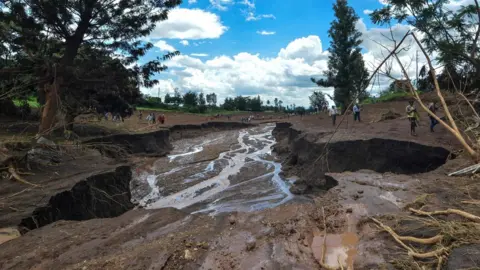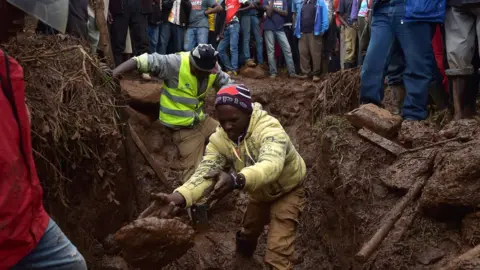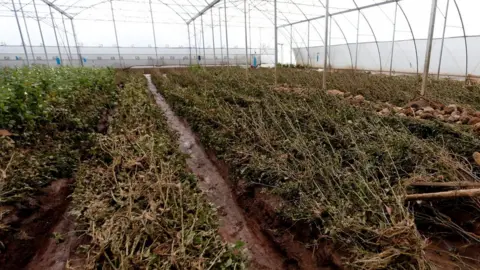Kenya's burst Patel dam was 'built illegally'
A Kenyan dam that burst - killing more than 40 people - was illegal, the country's water authority says.
The Patel dam was one of a number on a sprawling farm near Solai, 190km (120 miles) from the capital, Nairobi.
But none of them had a permit, a Water Resources Management Authority (Warma) spokesman said. The farm's manager has denied any wrongdoing.
Dozens of people are still missing from Wednesday's tragedy. There are fears that the death toll may rise.
It stood at 45 on Friday. Almost half the victims found so far were children. An investigation has been launched.
 AFP
AFPWarma spokeswoman Elizabeth Luvonga said the farm's dams lack the necessary permissions.
"None of them have permits. That is why they are illegal," she told Reuters news agency.
But the general manager of the farm, Vinoj Kumar, denied the accusation.
"All these dams were built about 15 to 20 years before. There's no [nothing] illegal," he said.

The bursting of the dam sent a reported 70 million litres of water towards the homes below.
According to Kenya's Daily Nation newspaper, the wall of water was about 1.5m high and 500m wide.
It destroyed everything in its path - including a primary school and power lines.

At the scene: 'Now we are digging for bodies'
By Anne Soy, BBC News, Kenya
Officers from the Kenyan military and Red Cross volunteers are combing through the flood path in Solai.
"Yesterday we were recovering bodies that were on the surface," a volunteer said on Friday. "But now they [officers] have begun digging into the mud searching for more victims."
 AFP
AFPWading through the mud with shovels and sticks, they are feeling for any bodies.
Families are helping to identify the dead.

'I clung to a tree'
"The flooding happened so quickly," Josephat Kimeli told the BBC. "While I was trying to run away, two of my daughters were swept away by the floodwaters.
"I was able to save my wife and two sons. But now I am in pain: I am pained by the loss of my children."
Ngugi Njoroge, one of the injured, told reporters he had been separated from his family.
"I was with my parents and my younger brother," he said from his hospital bed. "I don't know where they are. I was carried away by the water but I was lucky as I clung to a tree until the water subsided."
Nakuru County Governor Lee Kinyanjui said 40 people were missing.
 Reuters
ReutersThe dam, which is located on private farmland where flowers, macadamia nuts and coffee are grown, burst after heavy rains in the area, which continued into Thursday, making rescue efforts more difficult.
There are fears over other dams in the area. Mr Kinyanjui warned that at least one other "will have to be discharged to avoid disaster".
Prior to the Patel dam disaster, official statistics said heavy rains had already caused 132 deaths across the country since March.
More than 220,000 people have also had their homes destroyed.
The downpours came after a severe drought in the region, which left millions in need of food aid and the soil unable to absorb heavy rain.
